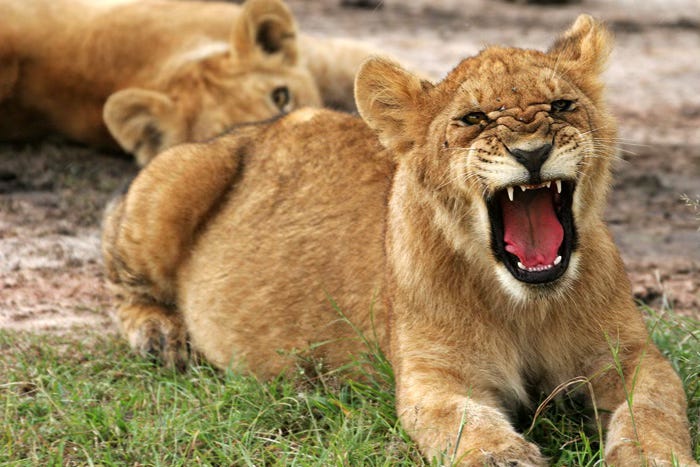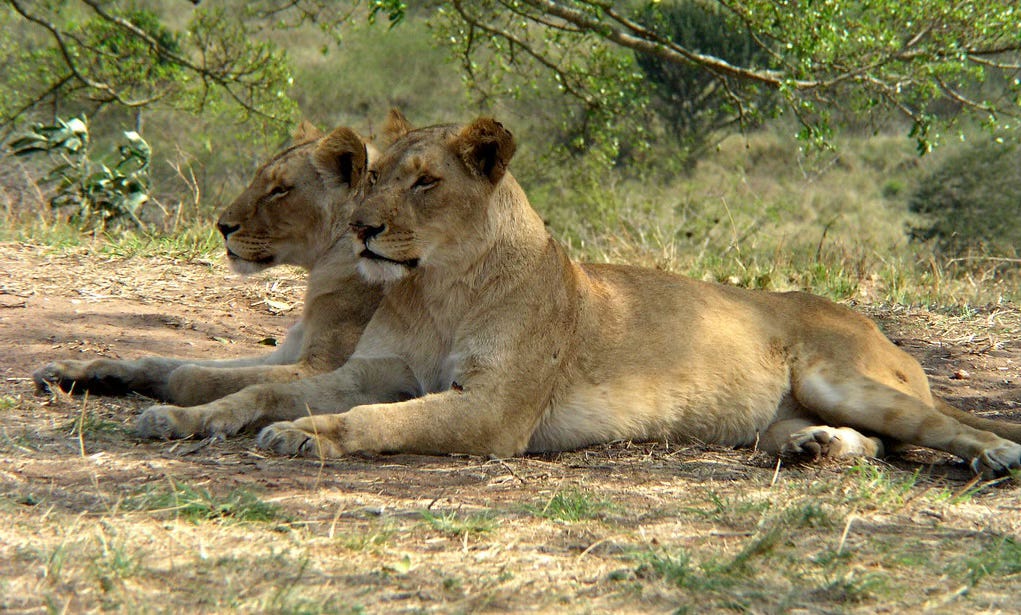Cub-petting tourists are 'killing lions softly', campaigners warn
By engaging in exploitation of captive lions, people are paving a soft journey towards the animals' violent end, according to a new campaign.

“You’re killing them softly.” This is the message a group of wildlife NGOs sent out to lion cub petters ahead of 10 August, a day dedicated to the iconic cats.
The campaign released for World Lion Day seeks to raise awareness of the role that cub petting and other seemingly innocuous activities play in South Africa’s controversial captive predator industry.
Captive predator pipeline
As I have previously reported, South Africa has a large captive lion industry which exploits the predators from crade-to-grave.
In the industry, females are used as breeding machines, as happens in animal farming more broadly. Their cubs are exploited for petting experiences and cub raising ‘voluntourism’. Once they get bigger, the cubs then often move on to being the stars of ‘walking with lions’ tours.
Ultimately, many of the lions who pass through this pipeline end up being sold off for canned trophy hunts, meaning people pay to kill them in an enclosure. Others may end up being sold into the live trade, such as for zoo exhibits.
Exploitation does not necessarily end with the lions’ death either. Their body parts, such as bones, are commercially exploited too, particularly for use in traditional medicine.
The campaign draws attention to the relations between the varied uses of captive lions during their lives. Launched by Voice4Lions, Blood Lions, FOUR PAWS South Africa, and Humane Society International/Africa, it spotlights how people’s engagement with the ‘softer’ elements of the industry is fuelling the commercial captive predator industry overall. The group says:
However well-intentioned people’s actions are, these cubs are not orphans, they have no conservation value, they are purely bred to feed an unethical and insidious industry that commodifies these predators.
The NGOs further stress that the industry does not solely involve lions, but other big cats like cheetahs and tigers too. They point out that there are at least 8,000 lions and thousands of other big cats in the country’s approximately 350 lion farms.
Lion farming exit plan
In 2021, the South African government released and endorsed a report that recommended closing down the lion farming industry and putting an end to associated exploitative activities like canned hunting.
Earlier this year, the government confirmed that lion farms will be shuttered and released a report that laid out ways a “voluntary exit” can be achieved. The exit plan suggests a range of options for closing down facilities, including euthanising all lions, surrendering them to “lion safe havens”, and phasing out lion populations over a two-year period through “trade opportunities.”
The report said these options “can be used as building blocks to create a variety of voluntary exit strategies to suit a wide range of circumstances.”
The exit plan also offers options for dealing with farms’ lion bone stockpiles, namely a two-year-long period of domestic trade to deplete them and the surrendering of lion bones to the authorities.
As highlighted in a recent paper about the links between lion farms and the bone trade by researchers at World Animal Protection, domestic trade in lion bones is legal in South Africa. Exports outside of the country, however, have not been permitted since a 2019 court ruling found prior quotas for exports to be unlawful and “constitutionally invalid” due to a lack of consideration of welfare issues.
Probes into the lion bone industry, which have looked into trading before and after the 2019 ruling, have pointed to South Africa’s captive predator industry being mixed up with illegal activity, alongside documenting dire welfare conditions for the animals involved. For instance, lead researcher of the aforementioned World Animal Protection paper, Dr Angie Elwin, explained of its findings:
Our study highlights the troubling reality of South Africa's captive lion industry. Legal activities are being exploited to facilitate illegal trade, and this is compounded by serious animal welfare violations and unsafe conditions for workers. Urgent action is needed to protect lions and people.
Concerns for other big cats and wild lions
The group of wildlife NGOs behind the ‘killing them softly’ campaign have commended the South African government for the progress it has made on ending lion farming. But there is much more to be done, they say.
They are calling on the Department of Forestry, Fisheries, and the Environment to publish “a detailed implementation plan with time-bound goals.” Other wildlife researchers called for similar after release of the voluntary exit report, as there is currently no deadline set for the industry’s closure.
The NGOs are also urging the authorities to widen the scope of prohibitions and “ensure the well-being of other predators by extending the ban to all captive big cats and prohibit their ownership as pets and playthings.”
Elsewhere, there are concerns about the government’s plans for wild lions and many other species.
As the Daily Maverick has reported, the government plans to create “mega-landscape conservation areas,” as detailed in its draft National Biodiversity Economy Strategy (NBES). In a nutshell, the strategy aims to massively increase the number of conservation landscapes in the country. It seeks to couple this expansion with extensive exploitation of wildlife in those areas.
The plan is in keeping with the country’s longstanding “model of commodifying wildlife, including lions,” says Adam Cruise, an investigative environmental journalist, author, and academic. This model has involved the ownership and commodification of wildlife on private lands, which the strategy intends to extend to traditional community areas, the Daily Maverick explained.

Some conservation scientists have welcomed the strategy as “a step in the right direction.” However, considering that South Africa’s wildlife commodification model has typically involved farming and ranching of wild animals, Cruise and others are concerned it conflicts with recommendations and efforts to close down captive breeding of some species, such as lions.
The plan involves “a huge expansion of trophy hunting and trade in animal products,” Cruise stresses. He has calculated that to achieve the NBES’ financial goals regarding increased ‘consumptive use of game from extensive wildlife systems’ by 2036, nearly a million animals would have to be trophy-hunted, including more than 10,000 wild lions, in the period up to then.
“It does not appear plausible that these increased numbers of animals will suddenly materialise in ‘extensive wildlife systems’, nor that the international demand for these exists,” he argues.
“While I applaud the decision to halt canned lion hunting,” says Cruise, “I am also not convinced that South Africa can realistically sustainably hunt wild-ranging or free-living lions. The NBES is silent on just how they will be able to do that.”
Lions in decline
In a 2016 assessment, the South African National Biodiversity Institute and Endangered Wildlife Trust said the country’s wild lion populations “declined substantially in the 19th century but have been stable or increasing over the past 20–30 years.” They estimated South Africa’s wild population to be around 3,500 individuals at that point.
Meanwhile, the latest International Union for Conservation of Nature Red List assessment said an estimated 23,000 or so lions live in the wild globally, which represents a decline of 30 percent in less than two decades. The assessment stressed that it is “incredibly challenging” to determine lion numbers, due to a lack of surveys of most populations and existing data effectively being unreliable or outdated.
The assessment pointed to destruction and degradation of lions’ habitat as the leading cause of their predicament. Other drivers include the killing of lions, both indiscriminately and for their body parts, and a lack of food, according to the Red List.
While the exact numbers of remaining lions may be unclear, it is evident that lions are struggling massively in the wild and subject to intense exploitation in the captive predator industry.
To ease the suffering of the iconic cats in captivity, campaigners have one clear message for people on World Lion Day: Stop killing them softly.



